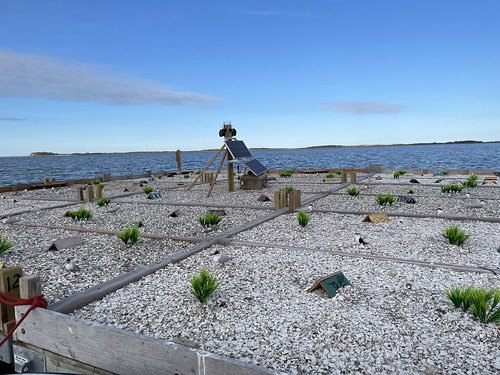Nesting Platform Initiative for Endangered Birds in Maryland Coastal Bays is a Big Success
Conservation Partnership Celebrates Successful Breeding Season for Common Terns

The artificial island after deployment in May 2022, complete with bird decoys to attract nesting waterbirds. Photo by Archer Larned, Maryland Coastal Bays Program
The partnership of Maryland Department of Natural Resources (DNR), Audubon Mid-Atlantic, and Maryland Coastal Bays Program, announced another successful year for the innovative conservation project to preserve three of Maryland’s state listed endangered colonial nesting waterbirds — the Common Tern, Royal Tern, and Black Skimmer, The floating, wooden-framed platform deployed in Maryland’s Atlantic Coastal Bays produced a highly successful Common Tern colony this summer before volunteers safely returned it to shore this week.
The project, now in its second year, is providing a floating wooden-framed platform as a nesting site for endangered colonial waterbirds, which have declined by a staggering 90-95% since the mid-1980s due to sea level rise and the erosion of their natural barren sand nesting islands in the coastal bays. The second year of the project was a resounding success. The platform was successfully used for nesting by 155 pairs of Common Terns, an increase of 132 pairs over the initial year, and making it the largest breeding colony of this species in the Coastal Bays in 2022.
“This June I had the great pleasure to ride out with the partners to view this island from a safe distance, and I applaud the ingenuity behind this important effort,” Governor Larry Hogan said. “Watching as the birds adopt this island was an incredible experience, and offers hope for the future of these species.”
This year it was discovered that the raft is being used by terns from several different locations. Banded terns from Poplar Island in Maryland, Hampton City in Virgina, and two terns from Argentina were all found nesting on the raft. 80% of the terns from the 2021 season returned to the raft for the 2022 nesting season. The project team also expanded in 2022. Maryland Coastal Bays Program hired Archer Larned, Ph.D., to the position of Coastal Bird Habitat Coordinator to assist with the project, using funds provided by US Wind.” We monitored the platform through the breeding season. Remote cameras installed on the platform showed Common Terns roosting initially in April. Nesting activity began shortly after and the numbers demonstrate the success of the project.”
Dave Brinker, of Maryland DNR Wildlife and Heritage Service, has been monitoring colonial nesting waterbird populations in Maryland since 1985.
“This summer’s highly successful breeding colony on the habitat raft demonstrates the value of providing emergency critical artificial breeding habitat as a temporary solution to maintaining a breeding population of Common Terns in the Maryland Costal Bays.” Brinker said. “But in order to fully recover and sustain populations of terns and skimmers in the coastal bays it is essential that we restore and maintain former sand islands that have been lost to erosion. To achieve that we will need a long-term strategy that allocates locally dredged sand for island restoration.”
Maryland DNR provides technical assistance, materials, and funding through federal Pittman-Robertson funds that the state receives from the U.S. Fish and Wildlife Service. Match for these federal funds comes from Maryland Program Open Space funds used to purchase land for state Wildlife Management Areas and from the Chesapeake Bay and Endangered Species fund (state income tax checkoff).
“It is truly impressive to see first-hand the great strides this endeavour has made protecting and providing a habitat for our endangered nesting birds,” Maryland DNR Secretary Jeannie Haddaway-Riccio said. “We are hopeful this investment is just the beginning of a long-term effort and strategy to restore this critical habitat along the Atlantic coast.”
Audubon Mid-Atlantic and Audubon’s Seabird Institute provide technical support and assistance with planning, coordination, and raft construction under a contract with DNR. Maryland Coastal Bays Program assists with local support, planning, coordination, and providing local volunteer assistance.

 1-888-373-7888
1-888-373-7888 233733
233733